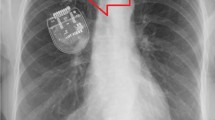Abstract
Background: Twiddler’s syndrome consists of rotation or manipulation of an implantable pulse generator (IPG) in its subcutaneous pocket by a patient, thus causing hardware malfunction. Methods: This syndrome is being reported more frequently in patients treated with deep brain stimulation (DBS). Results: We report the case of a woman who had received bed nucleus of stria terminalis (BNST) electrodes for obsessive-compulsive disorder (OCD) and developed twiddler’s syndrome a few months after surgery, causing hardware malfunction due to obsessive manipulation of the IPG. Conclusion: The patient did not have compulsions related to touching objects at admission, thus making it difficult to foresee and prevent TS.


Similar content being viewed by others
Abbreviations
- DBS:
-
Deep brain stimulation
- OCD:
-
Obsessive-compulsive disorder
- TS:
-
Twiddler’s syndrome
- IPG:
-
Implantable pulse generator
References
Astradsson A, Schweder PM, Joint C, Green AL, Aziz TZ (2011) Twiddler’s syndrome in a patient with a deep brain stimulation device for generalized dystonia. J Clin Neurosci 18:970–972
Bayliss CE, Beanlands DS, Baird RJ (1968) The pacemaker-twiddler’s syndrome: a new complication of implantable transvenous pacemakers. Can Med Assoc J 99:371–373
Burdick AP, Okun MS, Haq IU, Ward HE, Bova F, Jacobson CE, Bowers D, Zeilman P, Foote KD (2009) Prevalence of twiddler’s syndrome as a cause of deep brain stimulation hardware failure. Stereotact Funct Neurosurg 88:353–359
Carvallo JFD, Simpson R, Jankovic J (2011) Diagnosis and treatment of complications related to deep brain stimulation hardware. Mov Disord 8:1398–1406
Garg A, Mohan AL, Garell PC (2010) Placement of the internal pulse generator for deep brain stimulation in the upper back to prevent fracture of the extension wire due to generator rotation: case report. Park Dis 8
Machado AG, Hiremath GK, Salazar F, Rezai A (2005) Fracture of subthalamic nucleus deep brain stimulation hardware as a result of compulsive manipulation: case report. Neurosurgery 57:1318
Menghetti C, Zekaj E, Saleh C, Porta M, Servello D (2014) How to avoid twiddler’s syndrome in deep brain stimulation for dystonia. Neuromodulation 17:198–199
Mataix-Cols D, Rauch SL, Baer L, Eisen JL, Shera DM, Goodman WK, Rasmussen SA, Jenike MA (2002) Symptom stability in adult obsessive-compulsive disorder: data from a naturalistic two-year follow-up study. Am J Psychiatry 159(2):263–268
Moliz N, Katati MJ, Ianez B, Garcia A, Yagui E, Horcajadas A (2015) A twiddler's syndrome in a patient with obsessive-compulsive disorder treated with deep brain stimulation. Neurocirurgia 26(4):196–199
Penn DL, Wu C, Skidmore C, Sperling MR, Sharan AD (2012) Twiddler’s syndrome in a patient with epilepsy treated with deep brain stimulation. Epilepsia 53(7):e119–e121
Rufer M, Grothusen A, Mass R, Peter H, Hand I (2005) Temporal stability of symptom dimensions in adult patients with obsessive-compulsive disorder. J Affect Disord 88(1):99–102
Samuelsson J, Blomstedt P (2014) Twiddler’s syndrome in a patient with dystonic tremor treated with DBS. Open J Mod Neurosurg 4:193–195
Skoog G, Skoog I (1999) A 40-year follow-up of patients with obsessive compulsive disorder. Arch Gen Psychiatry 56:121–127
Sobstyl MR, Zabek M, Brzuszkiewicz-Kuzmicka G, Pasterski T (2017) Dual anchor internal pulse generator technique may lower risk of twiddler’s syndrome: a case series and literature review. Neuromodulation 9
Videnovic A, Verhagen Metman L (2008) Deep brain stimulation for Parkinson’s disease: prevalence of adverse events and need for standardized reporting. Mov Disord 3:343–349
Contributors
AF and GM contributed to the conception and design of the article, data acquisition, analysis and interpretation. All the authors were involved in critically drafting/revising the article for important intellectual content. Finally, they all gave final approval of the version to be published.
Author information
Authors and Affiliations
Corresponding author
Ethics declarations
Conflict of interest
None
Consent
The patient has consented to submission of this case report to the journal.
Rights and permissions
About this article
Cite this article
Franzini, A., Ranieri, R., Gambini, O. et al. Manipulating an internal pulse generator until twiddler’s syndrome in a patient treated with deep brain stimulation for obsessive-compulsive disorder. Acta Neurochir 160, 389–392 (2018). https://doi.org/10.1007/s00701-017-3412-9
Received:
Accepted:
Published:
Issue Date:
DOI: https://doi.org/10.1007/s00701-017-3412-9




